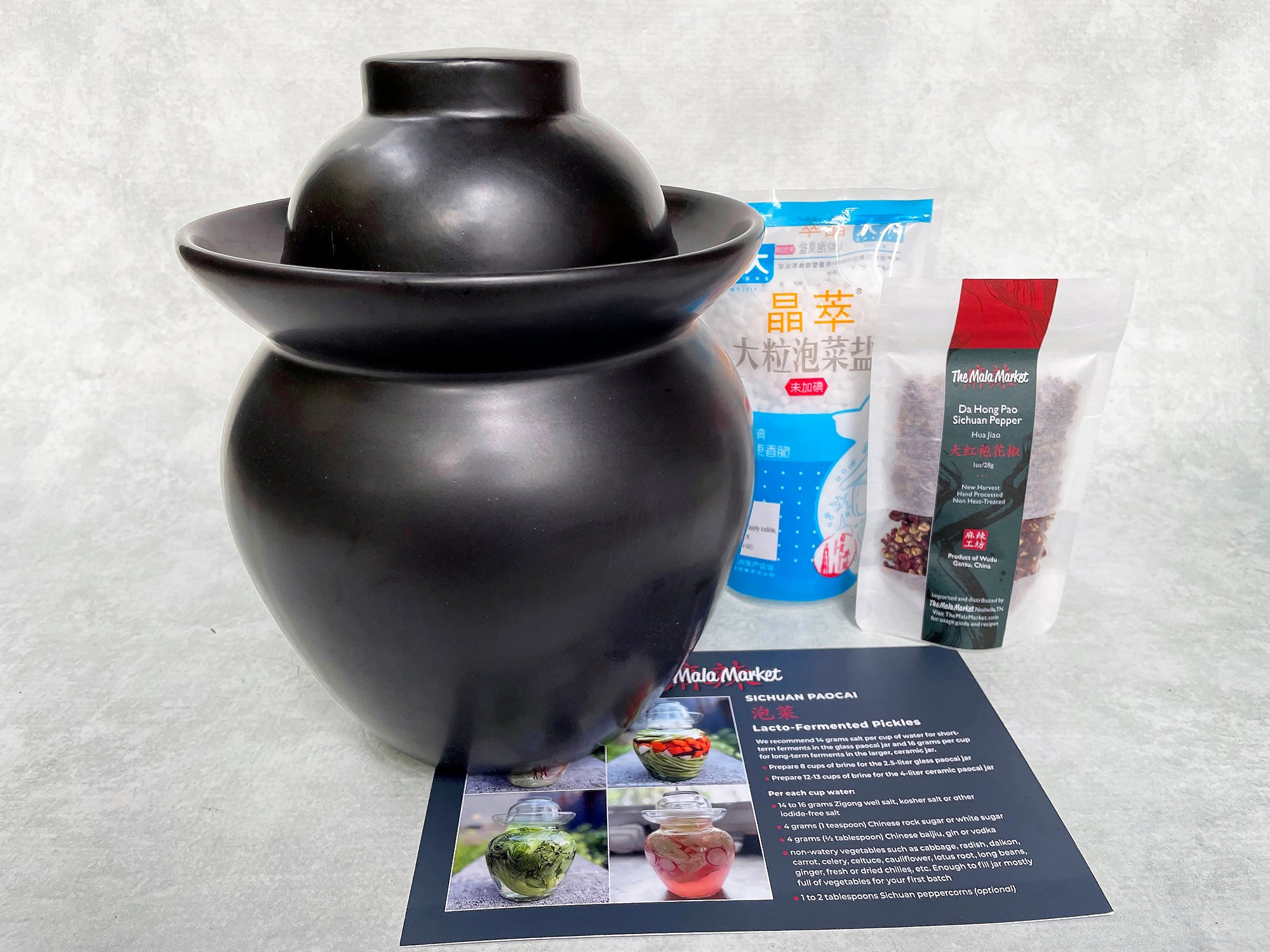This Sichuan Paocai Pickling Kit includes:
- 4-liter, matte-black porcelain ceramic pickling jar with lid
- Zigong well salt (extra-large-grain pickling salt), 12.3 ounces
- Da hong pao Sichuan pepper, 1 ounce
- Step-by-step instructions for making lacto-fermented pickles on a beautifully printed recipe card
Sichuan Paocai Pickling Kit (4L Black Ceramic Jar for Lacto-Fermentation)
Sold Out $85
This Sichuan Paocai Pickling Kit includes:
- 4-liter, matte-black porcelain ceramic pickling jar with lid
- Zigong well salt (extra-large-grain pickling salt), 12.3 ounces
- Da hong pao Sichuan pepper, 1 ounce
- Step-by-step instructions for making lacto-fermented pickles on a beautifully printed recipe card
We had this 4-liter, matte-black Chinese pickle jar custom made in Jingdezhen, the porcelain capital of China. We love its slightly pearlescent charcoal-black glaze and the fact that it is as beautiful as it is functional. In addition to the jar, this Sichuan pickling starter kit includes Sichuan's specialty pickling salt, a small bag of Sichuan pepper for flavoring and our meticulously tested recipe and instructions for making lacto-fermented pickles the Sichuan way.
The Jar
Designed thousands of years ago to be the ideal form for naturally fermenting vegetables, the shape of the Sichuan pickle jar has two inherent advantages:
1) The narrow opening and wide shoulders of the jar help keep the contents below the brine—which is key for mold-free natural fermentation—without the use of weights, and 2) The moat around the opening holds water that makes a natural seal, allowing the carbon dioxide released during fermentation to escape while sealing out unwanted oxygen and contaminants.
This particular jar is made of porcelain in Jingdezhen, China, in a high-fired, thick, durable clay form. It is glazed inside and out.
With a 4 liter (17 cup) capacity, the jar is a medium-large size for home use.
This jar also comes in matte white.
For a smaller jar, see our 2.5 liter mouth-blown glass paocai jar.
We recommend the glass jar for shorter ferments and the larger, opaque ceramic jars for longterm ferments (months or years), but you can certainly use either jar for all brine pickling.
The Salt
Years ago, we carefully carted home a Sichuan-style pickle jar from Chengdu, after having seen them in restaurants and homes and eaten their refreshingly tart and uniquely flavorful contents, called paocai. At home, we then learned to make pickled vegetables the Sichuan way, which forgoes vinegar in favor of souring over time through a salt brine and lacto-fermentation. We discovered just how easy and delicious it is, not to mention how probiotically good for you.
The key ingredient for pickling brine is salt, and while kosher salt or any iodide-free salt will work, serious Sichuan picklers will use nothing but their local Zigong well salt. This legendary salt comes from brine deep under the ground in Zigong, Sichuan, site of the world’s very first brine wells, drilled in 252 B.C.! For literally millennia, Sichuan cooks have sworn by this salt, for its purity, nutrients and, in the modern era, its lack of added iodide and anti-caking agents, which they feel ruins the taste of salt and the food it’s used in. Especially for pickling, where iodide can kill fermentation, serious cooks insist on this Sichuan salt.
And old-timers will also tell you the coarser the salt the better. According to the salt company, the extra-large grains of our pickling salt allow a sustained release that penetrates vegetables more efficiently and results in a brighter color, crispier pickle and less spoilage.
The Instructions
The detailed recipe card included with the kit will walk you through your first batch. We also have two detailed blog posts that provide additional information, photos and trouble-shooting tips:
Sichuan Lacto-Fermented Pickles (Paocai, 泡菜): Starting Your First Batch
Sichuan Lacto-Fermented Pickles (Paocai, 泡菜): Maintaining a Brine Long Term
Don't panic when the water turns cloudy and takes on the color of the contents or when you hear little burps of escaping gas. Those signs mean that fermentation has begun and you're on your way to pickles!
As you master the art of pickling the Sichuan way, your goal will be a "forever" brine that remains sour but fresh and pleasant for years to come: vegetables in, pickles out, in an ongoing cycle of fermentation.
Our Ultimate Guide to Making Sichuan Pickles also includes ideas and recipes for serving and cooking with your fermented vegetables:
- Take cabbage and thinly-sliced veg out after as little as 3 days to eat as a side dish, chopped and doused with chili oil
- Remove harder vegetables like daikon, green beans, carrots, celery, celtuce or cauliflower in a week or more, when they're soured to your liking, and eat as a side dish or noodle topping
- Remove long beans when soured to use in a long bean and pork mince stir-fry
- Ferment dried er jing tiao chilies to make Sichuan pickled peppers (pao la jiao)
- Pack Chinese mustard greens into the jar with a dry brine and eat the soured suan cai in a week or more in a stir-fry, noodle or soup
- Veer from the Chinese path, and make kimchi, sauerkraut or other ferments
International buyers: We cannot guarantee safe delivery of this jar outside of the U.S. Order at your own risk!
Returns: Please read product description and size carefully, as all cookware returns incur a restocking fee.
Size: 10.5 inches (height) x 8 inches; 4 liters (17 cups)
Material: Porcelain ceramic, glazed inside and out
Care: Hand wash. Do not add boiling water to jar; cool brine before adding to jar.
Share:







